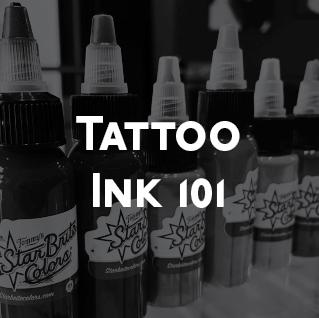An Intro to Tattoo Ink
Tattooing is the process of applying ink within the skin to produce a lasting image on the surface. The first tattoos were accomplished by rubbing ash or soot into cuts and allowing them to heal. When the cut healed, let behind were lines of black. But, as the tattoo industry grows and evolves, solutions for ink have grown. Comparatively, ink from 30 years ago has been developed and modified to be safer and even vegan.
The Ink Anatomy
Modern ink has two basic components: pigment and “carriers”. Pigment, which makes up the color of the ink, is usually a powder-based ingredient. But it’s not ready to be injected and absorbed into the skin. Therefore, a “carrier” is essential. Carriers are liquid based which help carry the pigment into the skin. There are several options for carriers in modern ink. Most commonly, ethyl alcohol – which is an organic compound – and distilled water. There is also rubbing alcohol, glycerin, propylene glycol, witch hazel, propylene glycol, Listerine, and methyl alcohol. These carriers are essential for the tattoo ink, as it prevents clumping of the pigments as well as prevents pathogens within the ink. In addition, it allows the ink to distribute evenly and consistently into the skin.
But What’s the Pigment Composed of?
Today, modern inks have a wide range of pigments. Therefore, there are lots of potential additives and colorants – over 200! Ink prior contained heavy metals, rust, charcoal, and even ink from ball point pens. As the tattoo industry develops, people are seeking inks safer than their processors. Although, the use of heavy metals is a controversial topic towards ink safety – there are still many colors which use them as they are essential for producing certain colors. Below are some common ingredients and their associated colors.
- Barium – White
- Iron – Black, red, brown
- Copper – Blue
- Titanium – White
- Aluminum – Violet and green
- Cobalt – Blue
- Chromium – Green
- Zinc – Yellow and white
- Nickel – Black
- Cadmium – Yellow, orange and red
- Lead – White, green
- Mercury – Red
Vegan and Organic Inks
As health awareness grows, people are more conscious of what they are putting into their bodies. Therefore, the demand for organic and vegan inks has risen. Additionally, one can even find shops which are completely vegan friendly – from tattoo inks to machines to aftercare products and even the furniture. In the past decade, many mineral based tattoo companies have switched to vegan and organic inks. Compared to other inks which contain heavy metals, these alternate options are much safer. Because they are absent of toxic and chemical substances. Below are some common ingredients in organic/vegan tattoo inks:
- Carbazole & Dioxazine – Purple
- Naphthol – Red
- Aluminum & Sodium – Blue
- Monoazo – Green
- Turmeric – Yellow and white
- Titanium – White
- Logwood & Carbon – Black
- Disazodiarylide – Orange
UV & Glow in the Dark Tattoo
UV Light and glow in the dark inks are typically comprised of different materials. Both has the possibility of containing phosphorus. Phosphorus has not been proven to be safe for use on the skin by the FDA. Furthermore, it is more likely to find phosphorus within glow in the dark tattoos. Phosphorus has been proven to cause cancer. Whereas UV inks can be made with FDA approved ingredients. Use caution when seeking out artists to do these types of tattoos.
Final Note
While modern ink is considered to be safe, the FDA has not approved any for injection into the skin. The US Food and Drug administration classifies tattoos and tattoo ink as cosmetic products. By the same token, hair dyes and hennas have also not been approved for use on skin, yet both are popular products amongst society. This is not to say that the FDA would not investigate tattoo ink if there were reports of it causing harm, however. But it is always important to understand and educate yourself on what you are using and putting into your body.
Sources:
- Azo pigment | chemistry | Britannica
- All you wanted to know about Vegan Tattoos | Tattoos Wizard
- What is Tattoo Ink Made From? [2021 Information Guide] (nextluxury.com)
- Tattoo Ink Safety & Their Ingredients to Know | MEDermis (medermislaserclinic.com)
- Are UV and Black Light Tattoos Safe? – AuthorityTattoo
- How Do Tattoos Work? | Quick Guide to the Science of Tattoos (cesargiovannyperez.com)

